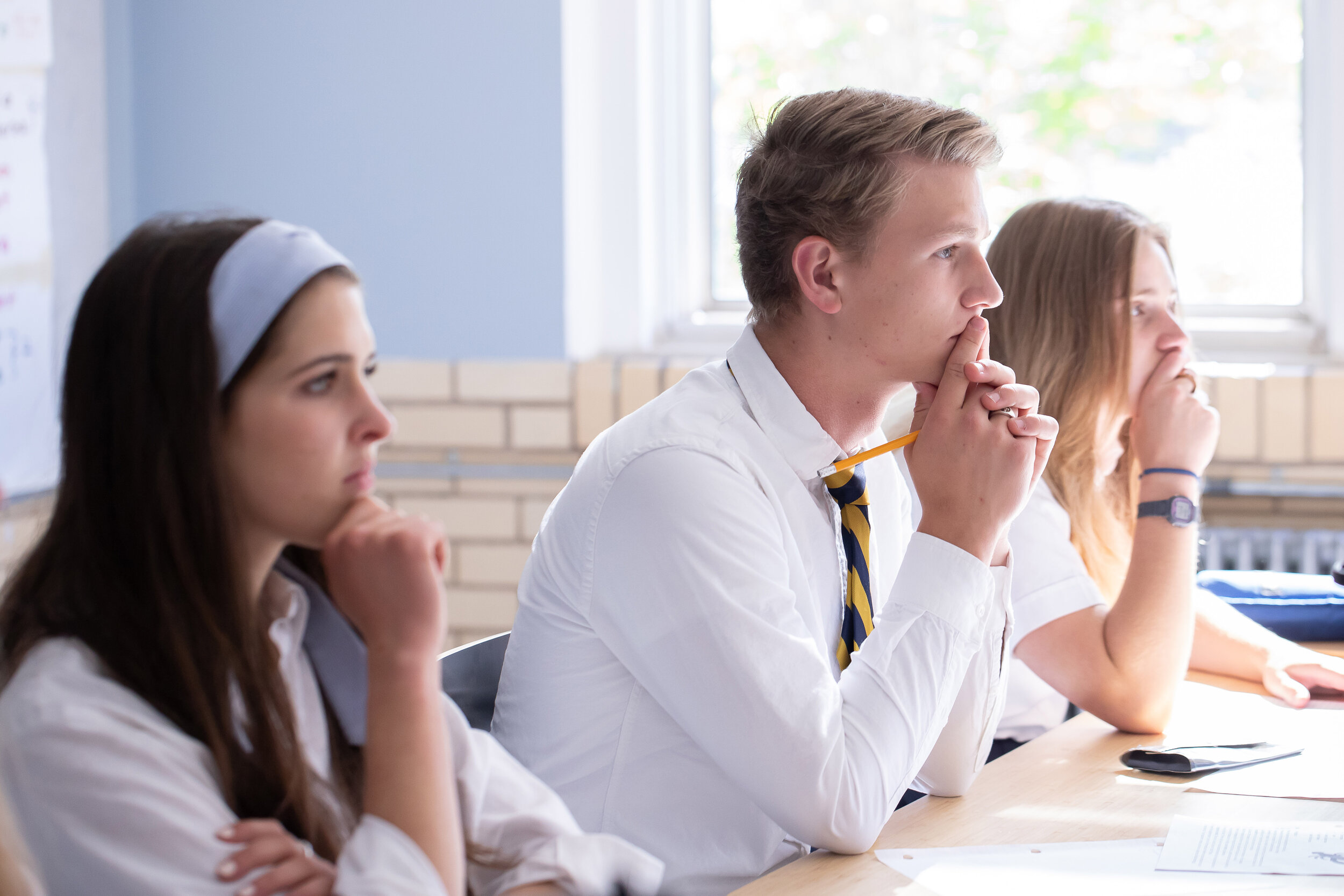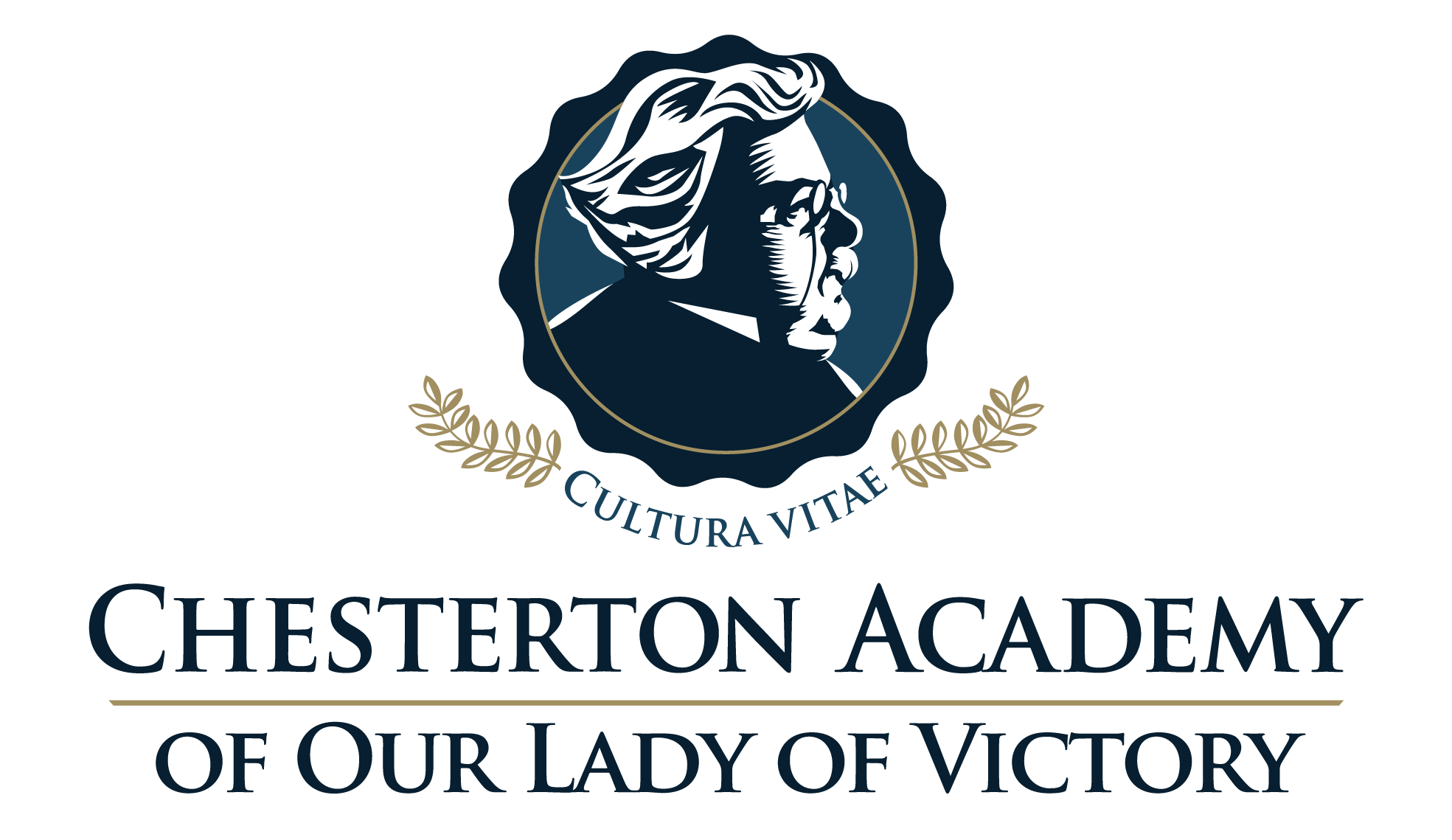
An Integrated, Classical Curriculum
Students at Our Lady of Victory enjoy a cohesive, content-rich education. A broad exposure to many different disciplines helps students expand their interests and uncover hidden talents. Each year builds on the previous, so that by the end of senior year, our students are articulate, clear-thinking, well-rounded, and — importantly — joyful individuals.
Humanities
History, literature, philosophy, theology, and languages are braided together in our integrated, classical curriculum.
Learn more
Math & Science
Math and science are also intimately connected; the logic of math is seen in philosophy and God’s handiwork is seen in the sciences.
Learn more
Fine Arts
Equal emphasis is given to the arts, so that every student learns to draw and paint, sing in the choir, act on the stage, give speeches, and engage in debate.
Learn more
The Humanities Program
Grade 9: Ancient World
Grade 10: Early Medieval Period
Grade 11: High Middle Ages to The Renaissance
Grade 12: Modern World
Literature
Our study of literature is tied to the study of history and the rest of the humanities. Students are first introduced to the classical epics of Homer and Virgil, then study early classics such as Augustine, Beowulf and Chaucer. As juniors, OLV students delve into great works by Dante, Cervantes, and Shakespeare, among others. Moving towards the modern period, OLV students tackle Dickens, Dostoevsky, Chesterton, Orwell, Jane Austen, Mary Shelley, C.S. Lewis, Sigrid Undset along with American literature. Each year, students explore the themes of these great works through Socratic discussion, essay writing and presentations. Reading and writing go hand in hand, and each student masters the art of the essay in their writing assignments in all subjects.
HISTORY
The history classes at Chesterton Academy form the backbone of our curriculum. The four-year history sequence covers ancient history through the Greek and Roman civilizations, early Church history, the Middle Ages, the Renaissance, and the Reformation and Counter-reformation. In senior year, students study the modern era, including the American and French Revolutions, the Industrial Revolution, the Communist Revolution, and the Cultural Revolution. Each history course is tailored to provide a colorful backdrop for literature, art, and science classes.
Philosophy
Philosophy, “the love of wisdom,” exercises the brain while it elevates the soul. The ability to understand abstract concepts leads to clear and systematic thinking in all things. We use philosophy to connect the humanities, but also to show its obvious connection to logic and mathematics. We study the development of philosophy from its classical roots focusing on Plato and Aristotle, its dramatic encounter with the early Church, its christening by St. Thomas Aquinas, and its deterioration in the modern era.
Theology
Theology, “the study of God,” is the context by which all other texts are studied. The principal theological texts studied are the Bible and the Catechism of the Catholic Church. We also read selections from the Church Fathers, Documents of the Church Councils, and Papal Encyclicals.
Foreign Language
OLV students are required to study Latin during their freshman and sophomore years. During those foundational years, OLV students learn Latin using the Henle method. They read and translate Caesar’s Gallic Wars along with other original texts. OLV upperclassman may elect to continue with Advanced Latin (Latin 3 and 4) or study Spanish 1 and 2. The OLV language programs emphasize translation as well as an appreciation of Latin or Spanish culture. Latin 4 students translate children’s books into Latin and create bound folio editions of their final projects. All students also take the National Latin Exam in which OLV students have historically excelled.
SPEECH & DEBATE
OLV students study speech & debate their sophomore year. Students spend the first part of the course learning the art of persuasion and practicing the skills of logos, pathos, and ethos. With an emphasis on multiple and frequent opportunities for public speaking before the class, including both original and historic short speeches, the quarter culminates in a team-policy style tournament on a chosen policy topic. Students’ diligence, creativity, and careful research bear the fruits of success, increased comfort with public speaking, and a greater appreciation for both sides of important and complex issues.

The Math & Science Program
math
Mathematics is the art of measuring. Science is the study of what can be measured. While math is woven together with the sciences, it is also connected to the humanities. It teaches logic, which is a basic philosophical principle. It teaches balance, which is a basic aesthetic principle. Math at Chesterton Academy covers Euclidean geometry and algebra, all the way through advanced Calculus.
Chesterton Academy of Our Lady of Victory is unique in offering three math tracks so students may pursue math studies consistent with their aptitude and interest. Placement testing along with parent consultation is utilized to determine the best track for your student.
MATH SEQUENCE
Foundations Track: Euclidean/Analytical Geometry (9th) - Algebra I (10th) - Algebra II/Trig (11th) - Pre-Calculus (12th)
Traditional Track: Euclidean/Analytical Geometry (9th) - Algebra II/Trig (10th) - Pre-Calculus (11th) - Calculus (AB) (12th)
Honors Track: Euclidean/Analytical Geometry (9th) - Honors Algebra II/Trig (10th) - Honors Pre-Calculus (11th) - Calculus (BC) (12th)
Science
Science is the study of the physical world, that is, of God’s creation. None of these subjects can be approached without a sense of wonder. It is fitting, therefore, to begin by looking up at the heavens, at the lights in the sky: Astronomy. Then we take a look at the world God created (Geology), the creatures he created (Biology), and the intricate substances of which all things are made (Chemistry). We end by gaining an understanding of the nature and properties of matter and energy (Physics).
SCIENCE SEQUENCE
Grade 9: Astronomy and Earth Science
Grade 10: Biology
Grade 11: Chemistry
Grade 12: Physics
The Fine Arts Program
Music
“A song is a thing of joy; more profoundly, it is a thing of love.”
Saint Augustine
At Our Lady of Victory, students are exposed to a wide variety of music and perform chorally several times a year. An OLV education includes music theory, performance, ear training, note reading, and musical analysis. Music history is taught chronologically with an emphasis on music development within the Church, and corresponds to the historical period in which the students are immersed. Students perform in at least three concerts a year: an Advent concert, the spring Fine Arts Night and the Baccalaureate Mass. Some representative sacred works that the OLV choir has performed are Jacques Arcadelt’s “Ave Maria”, Pitoni’s “Cantate Domino”, and the great O Antiphons in Gregorian chant. The OLV choir also performs spirituals, jazz pieces, ballads, and modern classics.
The music program at OLV is distinctive in several ways. First, the program highlights the sacred music of the Church, particularly Gregorian chant. Second, through Formation Fridays and other cultural events, OLV’s curriculum incorporates outside performances to further expose students to a range of musical genres and styles. In recent years, OLV students have attended the Colorado Symphony and a Rossini opera. Finally, the OLV music program aims to enrich and engage with the surrounding culture by performing at local benefits and charities. OLV students also regularly cantor at parish masses, participate in community musicals and orchestras, and compete in vocal and instrumental competitions.
Art
Students at OLV take art all four years. An art education at OLV includes the development of the students’ creative nature and provides them with tools and technique to express their ideas. Moreover, it exposes the students to great art and teaches the analytical skills with which to judge a work of art. Finally, OLV’s art curriculum situates the artistic endeavor within man’s great mission to participate in God’s ongoing creative work.
Art History and studio art SEQUENCE
Grade 9: Ancient Art History | Drawing and Calligraphy
Grade 10: Late Roman and Early European Art History | Pastels and Colors
Grade 11: Late Gothic, Renaissance, and Baroque Art History | Oils
Grade 12: Classical, Romantic, and Modern Art History | Oils
In studio art, OLV students create 4-5 projects every year. They begin by building their foundational skills and studying the elements of art and principles of design. As freshmen, they focus on drawing and learn the art of observation through projects such as value drawing, portraits, and cityscapes to develop an eye for value and scale. Sophomores are introduced to calligraphy techniques and illuminate manuscripts. They create graphite icons in the Byzantine style and study human anatomy in order to draw a person to scale correctly. Juniors are introduced to color theory and oil painting techniques. The OLV art program culminates in a senior painting project - either a copy of a masterwork or an original work of art. These projects require focused time, attention, and discipline to execute and represent the culmination of a rigorous program in studio art. Senior projects are displayed at OLV’s annual Fine Arts Night.
Besides studio art, OLV’s curriculum also incorporates art history. Students follow the development of artistic expression over time and study great representative works from each historical period. As part of the Formation Friday program, students visit local art exhibits. Students also engage in art-making - such as carpentry, graphic design, architectural drawings, and watercolor landscapes - as part of Inspiro Week and on their own in the local community. Finally, students at OLV study John Paul II’s “Letter to Artists” and take seriously its exhortation to engage with man’s creative capacity.
drama
“The beauty of theater is that, when all is said and done, you are giving a gift of yourself to the audience. As a cast, you spend months creating something rich and beautiful and then are asked to leave it all on the stage as an offering of self for the edification of your audience.”
Ms. Christina Ouyang, OLV drama teacher
All students at OLV are required to take classes in theater and perform in one play per year as sophomores, juniors and seniors. Rather than viewing the arts as merely passive entertainment, the OLV curriculum invites students to enter into the creative process. The focus of OLV’s theater program is on creating believable characters using natural methods to tell redemptive stories. In addition to studying acting techniques and learning to inhabit a role, OLV teaches students to analyze a script in order to understand the author’s vision and each character’s motivation. A good actor, in addition to mastering the craft of acting, must also be part literary critic, philosopher, and historian. Finally, the OLV theater program aims to help students develop the virtues of courage, perseverance, discipline, and collaboration.
performance SEQUENCE
Grade 10: Comedy
Grade 11: Drama
Grade 12: Shakespeare
Drama at OLV begins sophomore year when the students are introduced to the craft of acting and learn basic acting techniques. They study stage movement, character analysis, learn voice control and play theater games to practice their skills. The sophomores rehearse and perform a comedy, as their introduction to the dramatic arts. As juniors, students learn more advanced character development techniques and increase their facility with script analysis as they prepare to perform a drama, with universal themes. Finally, as seniors, students study, memorize, rehearse and perform a Shakespeare play as the culmination of their theater education.
Recent productions:
Peter/Wendy (by Jeremy Bloom)
The Rose of Treason (by James DeVita; based on the true story of Sophie Scholl and the White Rose movement)
MacBeth (by William Shakespeare)
It’s a Wonderful Life (adapted by Joe Landry)
The Attempted Murder of Peggy Sweetwater (by John Rustan and Frank Semerano)
Much Ado About Nothing (by William Shakespeare)













